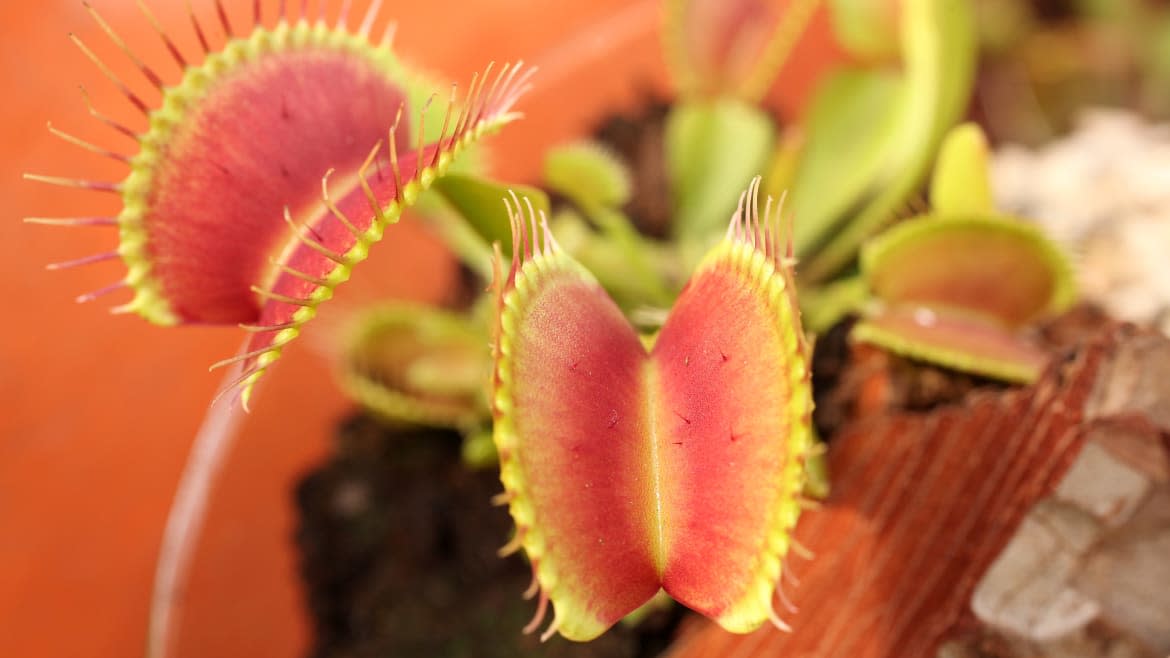This Venus Flytrap Could Revolutionize Brain Implants

Scientists are always on the lookout for ways to marry technology with nature. It seems they may have just struck a nerve—by creating an actual nerve.
Swedish researchers have engineered an artificial neuron that can control the snapping of a living Venus flytrap, a brand new development that has implications for future research linking artificial, synthetic devices with biological systems such as brain-machine interfaces (think Elon Musk’s Neuralink) or bionic prosthetics.
In a study published in Nature Communications on Tuesday, researchers from three Swedish universities constructed the neurons from polymers that can transport electrical signals to cells in the Venus flytrap that control the carnivorous plant’s mouth.
"We used Venus flytraps as a model system to demonstrate the biointegration of our artificial neurons,” Simone Fabiano, lead study author and a researcher in organic nanoelectronics at Linköping University, told The Daily Beast in an email. “Venus flytraps are easy to handle, and as a first demonstration, they represented an easy choice.”
While Venus flytraps and other plants don’t have nerves like humans and other animals, they are able to generate electrical impulses called action potentials that our own neurons use to convey information to neural neighbors in the brain and spinal cord.
To mimic an action potential (and get the plant to snap its lobes), Fabiano and his team ran a current through the artificial neuron’s “dendrite,” the tree-like end of a nerve cell that acts as a receiving bay for incoming information. That current is transferred to a device that stores electrical charge called a capacitor and acts as the neuron’s cell body. “The voltage starts building until it reaches a specific threshold, after which a voltage pulse is fired as [an output signal],” said Fabiano. Amplifiers at the neuron’s tail end also increase the magnitude of the signal as zapped to the cells of the Venus flytrap.
Aside from controlling a Venus flytrap’s snap, the artificial neuron also showed it was capable of Hebbian learning, a widely accepted theory in neuroscience that information in a neural network is stored between neurons in the form of weights. Greater stimulation leads to greater changes in weight (and vice versa), resulting in stronger or weaker neural connections.
“Hebbian learning is well known to scientists, but it has been hard to mimic at the hardware level,” said Fabiano. But he and his team managed to achieve this feat by developing an artificial version of a synapse (the juncture between two nerve cells where information is transferred) that thickens over time. This thickening strengthens the electrical impulse passing through the synapse—allowing information to be stored in the synapse’s chemical bonds over time. In essence, it’s able to evolve and learn how to be faster and more efficient in conveying its information.
While these synthetic cells are quick, they aren’t quick enough. Fabiano said the frequency at which these neurons operate is on par with human sympathetic neurons (the ones that prep your body for fight or flight). Ideally, the team would like them to be faster, mimicking the frequency of the human neocortex, the part of the human brain thought to be responsible for thought, attention, perception and episodic memory.
The next step is not only to get these artificial neurons to be faster but to extend them to other, more complex biological systems. They’re already looking to test out new versions in animal models.
Experts Are Ringing Alarms About Elon Musk’s Brain Implants
This development is a breakthrough in many ways, making melding organic with inorganic less a work of science fiction and more of a promising reality. Fabiano hopes these soft, biocompatible circuits will one day be incorporated into artificial intelligence, robotics, smart labels and even wearable technology to monitor health and wellness.
Don’t be surprised, then, for the day when you’re actually wearing your heart—at least a small neural piece of it—on your sleeve.
Got a tip? Send it to The Daily Beast here
Get the Daily Beast's biggest scoops and scandals delivered right to your inbox. Sign up now.
Stay informed and gain unlimited access to the Daily Beast's unmatched reporting. Subscribe now.

